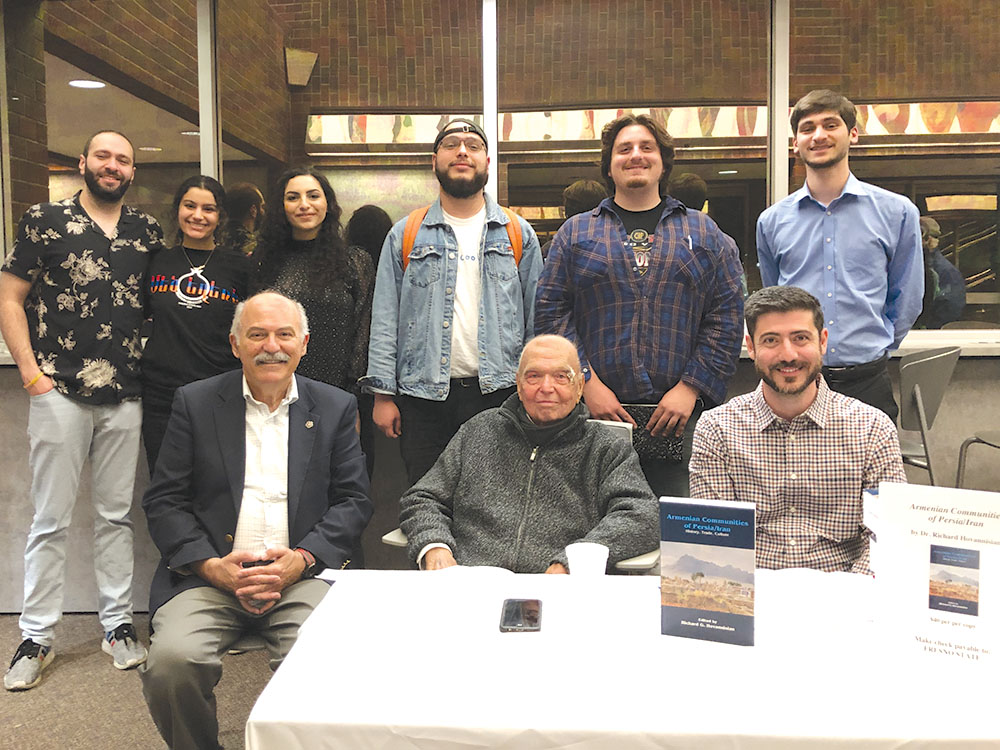
Photo: Andrew Hagopian
Carina Tokatian
Staff Writer
“The Persian Empire has been a major empire throughout history” stated Dr. Richard Hovannisian. He found the Empire’s long existence impressive, but also notable that Armenians “have lived here century after century”—a presence that can be traced as far back as the pre-Christian era.
On Wednesday, April 20, the Armenian Studies Program invited Dr. Richard Hovannisian to speak on his recent publication, Armenian Communities of Persia/Iran: History, Trade, Culture. Dedicated to his late wife, Vartiter, the lecture was part of the Armenian Studies Program Spring Lecture Series.
Dr. Hovannisian was born in Tulare, California and received his Bachelor’s and Master’s degrees from the University of California, Berkeley. He later earned his doctorate in history from UCLA. He is Emeritus Professor of Armenian and Near Eastern History at UCLA and served also as Associate Director of the G.E. von Grunebaum Center for Near Eastern Studies.
Dr. Hovannisian has authored and edited several volumes and scholarly articles pertaining to the Armenian Republic, the Genocide, and historic Armenia. Armenian Communities of Persia/Iran is the fifteenth and final volume of the “Historic Armenian Cities and Provinces” series. The book covers the Armenians in Persia from their early presence to the modern age.
Dr. Hovannisian began his lecture by sharing how the Persian Empire incorporated Armenia under its domain in the 6th century B.C. Despite this, Armenian princes were still permitted to continue as governors of the region. As the neighboring Byzantine Empire began to expand, the region where Armenians lived was caught between the clashes of the Byzantine and Persian Empires. Thus, Armenian kings began to play the game of what Dr. Hovannisian called “teeter-totter” between the East and the West as a strategy for survival.
Moving forward to the 13th through 15th centuries A.D., Dr. Hovannisian mentioned how some Armenian princes ruled in the region of Maku, located near Tabriz. It is here that Armenian inscriptions have been found on a bridge that dates to the 1300s.
The presence of Armenians in northern Iran has also been attested to by the Armenian monasteries in the area. One of the monasteries Dr. Hovannisian highlighted is Surb Tadeos, where it is believed that St. Thaddeus the Apostle visited.
Today Armenians living in Iran conduct pilgrimages there, holding a special festival for Vartavar. One important note Dr. Hovannisian underscored is how the present Iranian government, though an Islamic State, has overseen the maintenance of these Armenian landmarks.
In addition to Tabriz, another populous area prominent in Armenian activity was New Julfa. After Shah Abbas initiated a war against the Ottoman Empire in the early 17th c., he forced hundreds of thousands of Armenians to relocate from historic Armenia to Persia in 1604-1605. Many of the Armenians settled in New Julfa, the Armenian quarter of the Persian capital of Isfahan. Old Julfa was home to successful merchants who engaged in the silk trade.
Allowing the Armenians who settled in New Julfa to reestablish their communities without interference, Shah Abbas commissioned Armenians to expand their trade. Within one generation of their deportation, Armenians extended trade routes from New Julfa to Northern Europe. Influenced by European culture, they established their own theatre in the 1880s and produced plays like Shakespeare’s Othello in 1920.
The modern capital of Tehran was home to an estimated 100,000 Armenians at the time of the Islamic Revolution in 1979. Because of the Revolution, many Armenians resettled in the United States and in particular in Glendale, California and have established their own societies such as the Armenian Society of LA and the Iranahay Center.
Armenian Communities of Persia/Iran also contains chapters on Armenian mural painting, the Armenian Theater, Armenian artists, the Armenian Liberation movement, and the Armenians during World War I.
Reflecting on his lecture and the information shared, Dr. Hovannisian concluded by noting the remarkable saga of the Persian-Armenians who have “managed to endure throughout the centuries.” Maintaining their culture and dialect over that long period of time were in his words “most impressive.”
 Hye Sharzhoom Armenian Action
Hye Sharzhoom Armenian Action